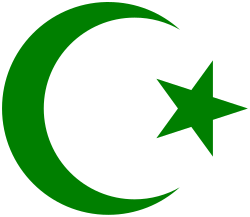Hilal (crescent moon)

Hilal ( Arabic هلال, DMG hilāl ' crescent moon ') is an Arabic term for the crescent of the waxing moon and one of the most important Muslim emblems today.
History of the symbol
In pre-Islamic Arabia, Hilal (or Hubal ) referred to both the moon god of the Thamud people and the very narrow crescent moon when it becomes visible for the first time after the new moon . In Persian and Sassanid art , the symbol was used on coins. The crescent moon was adopted as a decorative element in Islamic art. The sickle was used in mosaics during the construction of the Dome of the Rock in Jerusalem. Islamic coins also used the motif. In the religious field, the symbol was used as a final motif for minarets or on representations of the Kaaba .
As a crescent moon with a star on a red background, the symbol was introduced at the beginning of the 19th century as the flag of the Ottoman army . During the past two centuries, the crescent moon has become an important symbol in Muslim countries and found its way into the heraldry of numerous Islamic states. In addition, it is - like the International Red Cross - the symbol of the International Red Crescent . Organizations whose teachings differ significantly from those of Orthodox Islam, such as the Nation of Islam ("Black Muslims") in the USA, also use the symbol.
Meaning in Islam
The Islamic year is based exclusively on the lunar calendar . Numerous religious festivals and other dates are related to the appearance of the new moon. The fasting month of Ramadan only begins with the appearance of the crescent moon. This event had to be reported by several witnesses in the Sunni world. There could be shifts due to meteorological conditions. Religious authorities were able to explain the beginning of Ramadan after a set time on the basis of astronomical calculations without the moon being sighted.
List of flags with Hilal
- Currently existing, recognized, sovereign states
- Sub-areas of currently existing, recognized, sovereign states
Coconut Islands (Australia)
Anjouan (Comoros) until 2012
Johor (Malaysia)
Kedah (Malaysia)
Kelantan (Malaysia)
Selangor (Malaysia)
Terengganu (Malaysia)
Karakalpakistan (Uzbekistan)
Umm al-Qaiwain (United Arab Emirates)
- Currently existing, not generally recognized states
- Flags of historical states and territories
Eyâlet Egypt (1517–1882)
Khedivat Egypt (1882-1914)
Sultanate of Egypt (1914–1922; according to the personal standard of Muhammad Ali Pasha )
Kingdom of Egypt (1922–1953)
Bosnia and Herzegovina (1831–1832, 1878)
Vilâyet Tripolitania (1864-1911)
Kyrenaica (1949–1951; based on the banner of the Senussi Order )
Kingdom of Libya (1951–1969)
Standard of the Libyan King Idris
Ottoman Empire (1517–1844)
Hatay Republic (1938–1939)
League of Nations mandate for Syria and Lebanon (1920–1922)
Protectorate of South Arabia (1959)
South Arab Federation (1962 and 1967)
Kingdom of Kurdistan (October 1922 to July 1924)
Southwest Caucasian Republic (1918–1920)
Fur Sultanate (18th - 19th centuries)
Emirate of Jebel Shammar (1836–1921)
Principality of Moldova (1346-1859)
Principality of Wallachia (1310–1861)
Khanate of the Crimea (1449–1783)
Hafsiden (around 15th century)
Sultanate of Fadli (1670–1967)
Emirate of Beihan ( ca.17th century-1967)
Wahidi Balhaf (ca.1640–1967)
Emirate of Dhala ( ca.15th century-1967)
Autonomous Republic of Azerbaijan (1945-1946)
Bahawalpur (1885-1945)
Republic of Suvadiva (1959–1969)
Mahra (1549-1967)
Arab Islamic Republic (1974)
Rif Republic (1921-1926)
Khanate Khiva (1511-1920)
Basmachi (1921-1924)
Golden Horde (approx. 1240–1502)
People's Republic of Bukhara (1920–1924)
Emirate of Bukhara (1599–1920)
Sultanate of Aceh (1511-1903)
- Other flags and logos
Masyumi Party (Indonesia)
Nation of Islam (USA)
Flag of the Turkmen in Syria
2004 flag proposal for post-Baathist Iraq
Western Somali Liberation Front of Ethiopia (Ogaden)
German-Turks (unofficial)
Web links
Individual evidence
- ^ Rafat Amari: Islam: In the Light of History, Prospect Heights (Illinois) 2004, p. 275.
- ^ Gertrude Caton Thompson: Tombs and Moon Temple of Hureidah , 1944, p. 76
- ↑ a b c d Adel Theodor Khoury , Ludwig Hagemann , Peter Heine : Lexicon of Islam - History - Ideas - Design. Directmedia, Berlin 2001, Digital Library Volume 47. Keyword Hilal
-
↑ The symbol of the crescent moon with a star can also be found on the national flag of Libya, which was reintroduced in 2011, and the exact date of publication is not known in an English-language brochure ( The Libyan Flag & The National Anthem , published by the Ministry of Culture and Islamic Leadership of the Kingdom of Libya , the date of publication , quoted from Jos Poels on FOTW ( Memento of the original from November 4, 2015 in the Internet Archive ) Info: The archive link was inserted automatically and has not yet been checked. Please check the original and archive link according to the instructions and then remove this note. , 1997) like follows explained:
“The crescent is symbolic of the beginning of the lunar month according to the moslem calendar. It brings back to our minds the story of Hijra (migration) of our prophet Mohammed from his home in order to spread Islam and teach the principles of right and virtue. The Star represents our smiling hope, the beauty of aim and object and the light of our belief in God, in our country, its dignity and honor which illuminate our way and puts an end to darkness. ” [“ The sickle stands for the beginning a lunar month in the sense of the Muslim calendar. It reminds us of the story of the Hijra (excerpt) of our Prophet Muhammad from his homeland to spread Islam and the principles of law and virtue. The star represents the radiant hope, the beauty of striving and meaning and the light of our faith in God, in our country, his majesty and honor, which illuminate our path and put an end to darkness. "]
- ↑ Hilal - The crescent moon as a distinguishing mark F OCUS online Islamlexikon








































































































